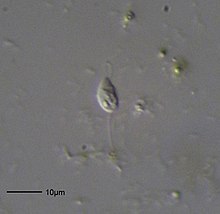| Bodonida | |
|---|---|

| |
| Bodo saltans | |
| Scientific classification | |
| Domain: | Eukaryota |
| Phylum: | Euglenozoa |
| Class: | Kinetoplastea |
| Subclass: | Metakinetoplastina |
| Order: | Bodonida Hollande, 1952[1] |
| Suborders[2] | |
Bodonida is an order of kinetoplastid flagellate excavates. It contains the genera Bodo and Rhynchomonas, relatives to the parasitic trypanosomes. This order also contains the colonial genus Cephalothamnium.
Taxonomy[edit]
Bodonida contains the following suborders and families:[2][3]
References[edit]
- ^ Hollande, A. (1952). Ordre des Bodonides (Bodonidea ord. nov.). In Traité de Zoologie, pp. 669–693. Edited by P. P. Grassé. Paris: Masson & Cie.
- ^ a b Guiry, M.D. & Guiry, G.M. 2018. AlgaeBase. World-wide electronic publication, National University of Ireland, Galway. http://www.algaebase.org/browse/taxonomy/?id=141999 ; searched on 25 April 2018.
- ^ Cavalier-Smith, Thomas (2016). "Higher classification and phylogeny of Euglenozoa". European Journal of Protistology. 56: 250–276. doi:10.1016/j.ejop.2016.09.003. PMID 27889663.
Well, that’s interesting to know that Psilotum nudum are known as whisk ferns. Psilotum nudum is the commoner species of the two. While the P. flaccidum is a rare species and is found in the tropical islands. Both the species are usually epiphytic in habit and grow upon tree ferns. These species may also be terrestrial and grow in humus or in the crevices of the rocks.
View the detailed Guide of Psilotum nudum: Detailed Study Of Psilotum Nudum (Whisk Fern), Classification, Anatomy, Reproduction